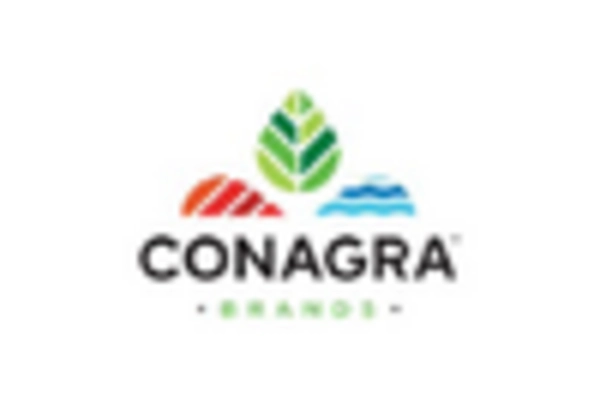Diverse Product Offerings
The Microwaveable Food Market is characterized by a diverse range of product offerings that appeal to various consumer segments. From frozen meals to snacks and desserts, the variety available allows consumers to choose options that fit their dietary preferences and lifestyles. This diversity is further enhanced by the introduction of plant-based and organic microwaveable products, which cater to the growing health-conscious demographic. Market data indicates that the plant-based segment within the microwaveable food category is projected to grow by over 10% in the coming years. This trend suggests that the Microwaveable Food Market is adapting to changing consumer demands, thereby expanding its reach and potential customer base.
Convenience and Time Efficiency
The Microwaveable Food Market is experiencing a surge in demand due to the increasing need for convenience and time efficiency among consumers. As lifestyles become busier, individuals are seeking quick meal solutions that do not compromise on taste or nutrition. This trend is particularly evident among working professionals and families, who often prioritize meals that can be prepared in minutes. According to recent data, the microwaveable food segment has seen a growth rate of approximately 5% annually, reflecting a shift in consumer preferences towards ready-to-eat options. The Microwaveable Food Market is thus positioned to capitalize on this trend, offering a variety of products that cater to the fast-paced lifestyle of modern consumers.
Rising Demand for Healthy Options
The rising demand for healthy options is significantly influencing the Microwaveable Food Market. Consumers are increasingly seeking meals that are not only convenient but also nutritious. This shift is prompting manufacturers to reformulate their products, reducing sodium, sugars, and unhealthy fats while incorporating whole grains, vegetables, and lean proteins. Market Research Future indicates that health-oriented microwaveable meals are gaining traction, with sales expected to rise by approximately 8% over the next few years. This trend suggests that the Microwaveable Food Market is responding to consumer preferences for healthier eating, thereby enhancing its market position and appeal.
E-commerce Growth and Online Shopping Trends
The growth of e-commerce and online shopping trends is reshaping the Microwaveable Food Market. As more consumers turn to online platforms for grocery shopping, the demand for microwaveable food products is likely to increase. E-commerce offers convenience, allowing consumers to browse a wide range of products and have them delivered directly to their homes. Recent statistics show that online grocery sales have surged, with a notable percentage attributed to microwaveable food items. This trend indicates that the Microwaveable Food Market must adapt to the digital landscape, optimizing online presence and distribution strategies to capture the growing segment of online shoppers.
Technological Advancements in Food Preparation
Technological advancements in food preparation are playing a crucial role in shaping the Microwaveable Food Market. Innovations in packaging and cooking methods have led to improved product quality and safety, enhancing the overall consumer experience. For instance, the development of microwave-safe packaging materials has allowed for better preservation of flavors and nutrients, making microwaveable meals more appealing. Additionally, advancements in microwave technology itself, such as smart microwaves that offer precise cooking instructions, are likely to further boost the market. As consumers become more tech-savvy, the Microwaveable Food Market is expected to benefit from these innovations, potentially increasing sales and customer satisfaction.


















Leave a Comment